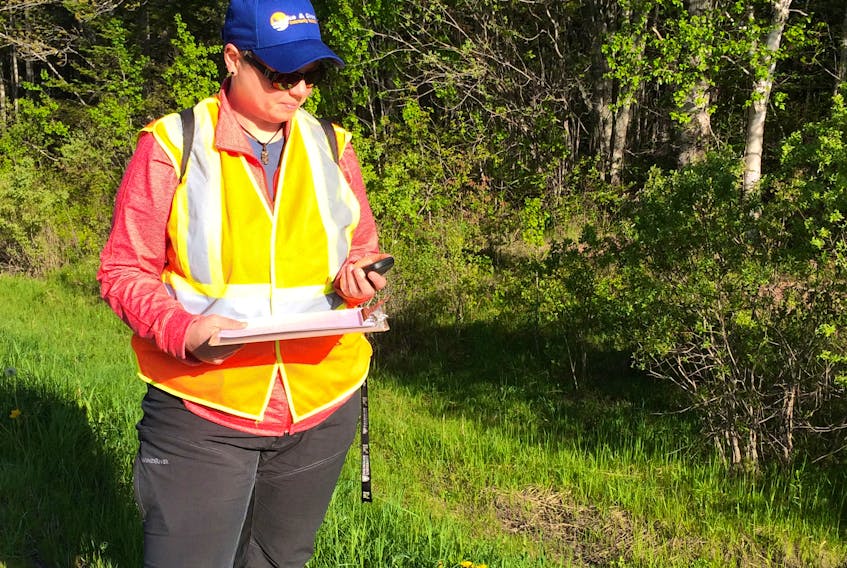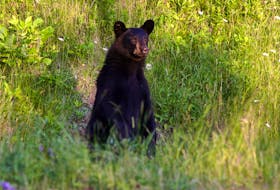AMHERST – Amelia Barnes is going to see more than her fair share of roadkill this summer on both sides of the border that runs between Nova Scotia and New Brunswick.
The graduate student in environmental studies at Dalhousie University is participating in a Nature Conservancy of Canada project this summer that will track wildlife sightings near the border that’s not only a busy transportation hub but is also a valuable wildlife corridor along the Isthmus of Chignecto.
“I’m going to see a lot of roadkill this summer,” Barnes said. “I have a whole album full of pictures of dead animals and it’s tough at times. Even though I have to look at a lot of dead animals, hopefully it will contribute to finding ways to prevent it from happening. I don’t want things to die on the road, but if they do I want to be able to find them and record what happened.”
Her research will be part of the NCC’s WildPaths Maritimes project being conducted in partnership with the New Brunswick Department of Transportation and Infrastructure, the Atlantic Wildlife Institute and Dalhousie University, to enhance conservation and improve safety for both wildlife and people in the border area.
“The Nature Conservancy of Canada and numerous other conservation organizations have been working for a number of years on the Chignecto Isthmus trying to protect wildlife habitat and looking at how connected the habitats are,” Paula Noel, New Brunswick program director with the Nature Conservancy of Canada, said. “We’re concerned about wildlife population and being able to move freely in and out of Nova Scotia.”
Noel said this project is the next step in the process and builds on the acquisition of more than 1,200 hectares of property along the isthmus in both Nova Scotia and New Brunswick.
“Now we’re taking a closer look at what the barriers preventing wildlife from moving across this landscape,” Noel said. “An obvious one is roads. We want to look at roads and get a sense of where there are issues with wildlife trying to get across.”
Barnes will be doing a comprehensive survey of roads across the isthmus and how wildlife interacts with them. She’ll be reacting to reports and photographs of wildlife killed on roads and also driving and walking the routes to determine if wildlife approach the roads and turn back.
One of the goals of the project is to identify sections of highways that present the greatest barriers to wildlife. Barnes and other researchers from Dalhousie University will conduct detailed surveys along Highways 15, 16, 134 in New Brunswick, and Highways 104, 366, 6, 204 in Nova Scotia.
The research will help identify where wildlife is most frequently interacting with roads and where solutions such as wildlife tunnels may be beneficial.
“We’re trying to find ways to make highways safer for wildlife in helping them get safely across and also have them not be a danger to motorists,” Noel said.
To assist the project, the Nature Conservancy of Canada is seeking volunteers to become citizen scientists by taking photos and documenting wildlife using a mobile application called iNaturalist. The app allows observers to record species of wildlife, location of wildlife, and other valuable information, and add it to a database.
The NCC is working with its partners to secure a permanent wilderness corridor for wildlife in the region. One of those partners is the Atlantic Wildlife Institute.
“We feel it is necessary to document wildlife activity and find ways to help protect wild spaces that will allow our native species to freely move within their ranges,” institute wildlife care director Pam Novak said. “Without appropriate natural spaces for breeding, foraging and migration stop overs, wildlife and environmental health will deteriorate.”
Protecting a wilderness corridor and “habitat connectivity” on the Chignecto Isthmus is essential to allow healthy renewal of populations, especially with greater migration expected due to climate change. Novak fears if the narrow border area is further fragmented by roads and development, wildlife populations in Nova Scotia will decline over the long-term, due to isolation from other populations in eastern North America.
Anyone wishing to volunteer with the WildPaths Maritimes project on the Chignecto Isthmus is encouraged to contact the Nature Conservancy of Canada’s Fredericton office at 1-877-231-4400.
Twitter: @ADNdarrell









